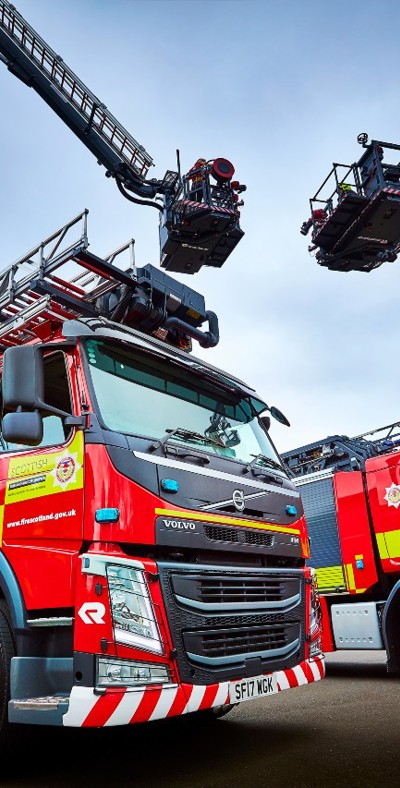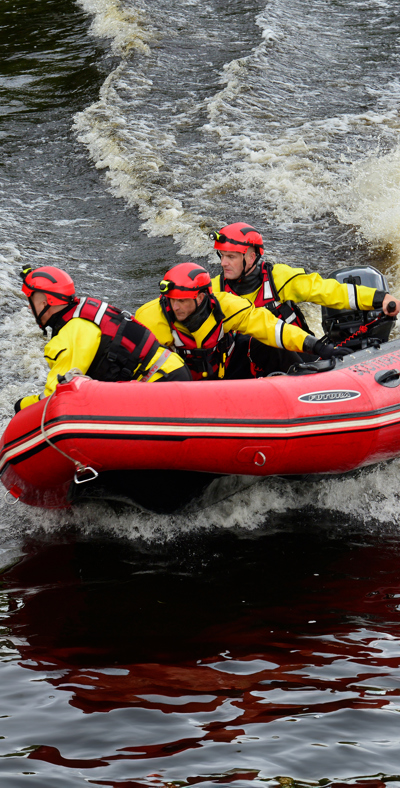Fire service must address changing community risk and ageing estate
Scotland's fire and rescue service must adapt to meet the risks of climate change and address significant issues across its ageing estate.
That's the message from one of the country's most senior fire officers as the Scottish Fire and Rescue Service (SFRS) launches an online survey on what the emergency service should look like in the future.
Deputy Chief Officer Stuart Stevens said SFRS must ensure its crews and stations are in the right place to meet current and future risks such as flooding and wildfires.
SFRS is asking communities across Scotland to make their voice heard as it considers changes to the location of its firefighters and fire stations. He said:
We want to be a modern service that is ready for the challenges of Scotland’s future.
“To achieve this, there are changes that we must consider. Scotland has changed and so must its fire and rescue service.
“For example, we have spent a long time analysing the changing community risk across the country and we know some of our stations and appliances are located based on historical risk, such as heavy industry that no longer exists.
“As a national emergency service, we must ensure we have the right resources, in the right place, at the right time.”
DCO Stevens warned that some fire stations across Scotland have been deemed “not fit for purpose” and require urgent investment to make them safer and more suitable.
This includes 14 stations with Reinforced Autoclaved Aerated Concrete (RAAC) panel issues.
Almost half of fire stations have been deemed in "poor or bad" condition while two-thirds of the total SFRS estate across Scotland is more than 30 years old.
DCO Stevens continued: “Some of our ageing buildings are no longer fit for purpose and require urgent action.
“We have a significant number of fire stations without provisions such as dedicated locker rooms, dignified facilities or sufficient showering facilities.
“Our buildings need to be safe, provide welfare facilities and comply with guidelines around decontamination after incidents to help protect our firefighters’ health.
“While we welcome the uplift in our capital budget, we do not have the budget to address this and doing nothing is simply not an option. We must find a permanent solution.
“By moving or merging stations in similar geographical locations, for example, we could address some of these welfare concerns while ensuring that we are best placed to meet the changing community risk across Scotland.”

DCO Stevens also highlighted how SFRS now responds to fewer house fires but more incidents of flooding and larger, more intense wildfires.
He said: “Last year we saw extreme weather events that placed an unprecedented demand on our emergency service.
“This included one of the largest wildfires on record at Cannich in the Highlands and Storm Babet, which devastated many communities in the north east.
“These types of incidents require the deployment of hundreds of firefighters and often occur in areas where we do not have permanently staffed stations.
“We have prioritised investment and bolstered our fleet in recent years with the addition of 20 specialist water rescue boats and the implementation of 25 dedicated wildfire stations across Scotland.
“But we expect climate change to intensify and present further challenges that we must be prepared to meet.”

Other changes SFRS will consider in the future includes the development of the firefighter role, how and when resources are crewed when responding to emergencies, and a review of SFRS corporate buildings.
The survey is open until the end of June and views gathered will help to develop change options for full public consultation later this year.
DCO Stevens added: “We are calling on people across the country to share their feedback and tell us what you want from the Scottish Fire and Rescue Service.
We know we can do more to keep Scotland safe. We want to focus on prevention to make communities safer so we can reduce demand on both us and other public services.
“For example, we want to develop the role of our firefighters to take on more prevention work in our communities or support partners with emergency response activities, however this would require investment.
“Our communities are changing with more people living longer at home who need additional support.
“The benefits to the people of Scotland in working closer with our public service partners could be significant.”
Ends
Shaping Our Future Service: Your Say survey runs until 30 June 2024: https://firescotland.citizenspace.com/planning-and-performance/shaping-our-future-service-your-say/
NOTES TO EDITOR
Changing risk:
- House fires in Scotland have decreased by almost half in the past 20 years (8,131 in 2003-04, 4,305 last year, -47%)
- The total number of fires across Scotland has reduced by 56% in the same period (61,762 in 2003-04, 26,825 last year)
- While fires overall have decreased, the number of other incidents SFRS attends has increased. Non-fire incidents such as flooding, road traffic collisions, rescues and assisting other agencies have increased by 83% over the past decade (9,166 in 2013-14, 16,783 last year)
- Non fire incidents increased from 11% in 2013-14 to 17% last year of the total incidents SFRS attended. This rise is expected to continue
- Since 2010 there have been eight wildfires recorded which have lasted more than five days. All eight of these incidents have been since 2018.
- Flooding risk has increased steadily over the past decade – SFRS has attended more than 15,000 flooding incidents in the past decade
Ageing estate:
- In 2018 Audit Scotland described SFRS backlog in capital spend requirements as “insurmountable”.
- SFRS assets are worth around £0.5 billion, comprising land and buildings, including 356 fire stations, 1,620 fleet vehicles and tens of thousands of items of operational equipment;
- SFRS assets demand a bare minimum investment of £60 million every year
- Around 61% of SFRS buildings are over 30 years old; 45% of operational property estate is currently in poor or bad condition, and 75% is deemed unsuitable;
RAAC:
- The 14 fire stations with Reinforced Autoclaved Aerated Concrete (RAAC) issues are: Crewe Toll, Cumbernauld, Dalkeith, Galashiels, Hawick, Helensburgh, Huntly, Liberton, Livingston, Marionville, Milngavie, Portree, Stewarton, Tranent;
- SFRS has in place temporary supports to reinforce areas of the roofing and continue to regularly monitor these measures;
- In most cases, the safest and most cost-effective solution is to rebuild these stations; it is anticipated that replacing the 14 fire stations with RAAC would cost in the region of £77 million;

